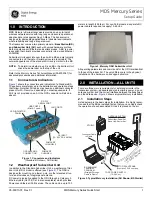
MAX-M10S - Integration manual
Allowing more ephemerides to be downloaded before going into the "POT" or the "Inactive for update"
state can help improve the quality of the fixes and reduce the number of wake ups needed to
download ephemerides at the cost of extra time in the "Acquisition" state (only when an inadequate
number of ephemerides are downloaded from tracked satellites).
2.7.3 Backup modes
A backup mode is an inactive state where the power consumption is reduced to a fraction of that
in operating modes. The receiver maintains time information and navigation data to speed up the
receiver restart after backup or standby mode.
MAX-M10S supports two backup modes: hardware backup mode and software standby mode.
2.7.3.1 Hardware backup mode
The hardware backup mode allows entering a backup state and resuming operation by switching the
power supplies on and off. The receiver automatically enters the hardware backup mode if the VCC
and V_IO are removed. The hardware backup mode always requires an independent backup battery.
V_BCKP must be supplied to maintain the backup domain (BBR and RTC) to allow better TTFF,
accuracy, availability, and power consumption at the next startup. As V_IO is not supplied, the PIOs
cannot be driven by an external host processor. If driving of the PIOs cannot be avoided, buffers are
required for isolating the PIOs.
2.7.3.2 Software standby mode
Software standby mode allows control over the backup state with the software command UBX-
RXM-PMREQ. The V_IO and VCC must be supplied, however VCC supply is internally disabled to save
power. The V_IO supply maintains the BBR, RTC, and PIOs.
Entering the software standby mode clears the RAM memory including the receiver configuration.
To maintain the configuration, store it on both RAM and battery-backed RAM (BBR) layers.
The software standby mode can be set for a specific duration, or until the receiver is woken up by
a signal at a wake-up source defined in UBX-RXM-PMREQ. The possible wake-up sources are UART
RX, EXTINT, and/or SPI CS pin. Refer to the interface description [
] for more information on UBX-
RXM-PMREQ message. System reset with RESET_N signal also terminates the software standby
mode and restarts the receiver. A system reset clears the BBR content.
As V_IO is supplied, the PIOs can be driven by an external host processor. No buffers are required for
isolating the PIOs, which reduces cost.
The "force" flag must be set in UBX-RXM-PMREQ to enter software standby mode.
V_BCKP should be left open if not used.
2.8 Time
Maintaining receiver local time and keeping it synchronized with GNSS time is essential for proper
timing and positioning functionality. This section explains how the receiver maintains local time and
introduces the supported GNSS time bases.
2.8.1 Receiver local time
The receiver is dependent on a local oscillator for both the operation of its radio parts and also for
timing within its signal processing. No matter what nominal frequency the local oscillator has, u-blox
receivers subdivide the oscillator signal to provide a 1-kHz reference clock signal, which is used to
UBX-20053088 - R03
2 Receiver functionality
Page 40 of 89
C1-Public
















































